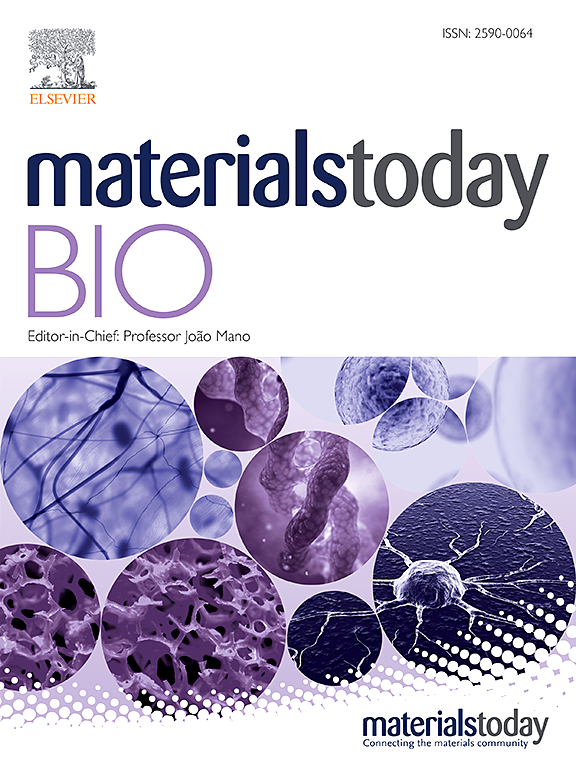GSH/ ph反应性铜基级联纳米复合物在口腔鳞状细胞癌中通过铜下沉/铁下沉/坏死下沉诱导免疫原性细胞死亡。
IF 8.7
1区 医学
Q1 ENGINEERING, BIOMEDICAL
引用次数: 0
摘要
口腔鳞状细胞癌(OSCC)仍然是一个艰巨的挑战,由于高复发率和疗效有限的传统治疗。免疫疗法具有潜力,但其有效性往往受到患者反应性低的限制。本研究提出了一种新的治疗策略,使用谷胱甘肽/ ph反应性铜基级联纳米复合物诱导OSCC的免疫原性细胞死亡(ICD)。合成的纳米复合物PC@B-H利用酸性和还原性肿瘤微环境释放铜离子和铅白丹素,触发一系列细胞死亡机制,包括铜坏死、铁下垂和坏死下垂。这一多功能系统不仅增强氧化应激,还能消耗谷胱甘肽,促进脂质过氧化,破坏线粒体功能,从而导致强大的肿瘤抑制。此外,ICD的诱导促进树突状细胞成熟和细胞毒性T淋巴细胞浸润,提供持久的抗肿瘤免疫。该研究表明,PC@B-H在最小的全身毒性下实现了92.3%的肿瘤生长抑制率,为通过细胞死亡途径和免疫激活联合提高OSCC治疗效果提供了一条有希望的途径。本文章由计算机程序翻译,如有差异,请以英文原文为准。

GSH/pH-responsive copper-based cascade nanocomplexes inducing immunogenic cell death through cuproptosis/ferroptosis/necroptosis in oral squamous cell carcinoma
Oral squamous cell carcinoma (OSCC) remains a formidable challenge due to high recurrence rates and limited efficacy of conventional treatments. Immunotherapy holds potential, but its effectiveness is often restricted by low patient responsiveness. This study presents a novel therapeutic strategy using GSH/pH-responsive copper-based cascade nanocomplexes to induce immunogenic cell death (ICD) in OSCC. The fabricated nanocomplex, PC@B-H, leverages the acidic and reducing tumor microenvironment to release copper ions and plumbagin, triggering a cascade of cell death mechanisms including cuproptosis, ferroptosis, and necroptosis. This multifunctional system not only enhances oxidative stress but also depletes glutathione, promotes lipid peroxidation, and disrupts mitochondrial function, leading to robust tumor inhibition. Additionally, the induction of ICD facilitates dendritic cell maturation and cytotoxic T lymphocyte infiltration, providing durable anti-tumor immunity. The study demonstrates that PC@B-H achieves a 92.3 % tumor growth inhibition rate with minimal systemic toxicity, offering a promising avenue for enhancing the efficacy of OSCC treatment through combined cell death pathways and immune activation.
求助全文
通过发布文献求助,成功后即可免费获取论文全文。
去求助
来源期刊

Materials Today Bio
Multiple-
CiteScore
8.30
自引率
4.90%
发文量
303
审稿时长
30 days
期刊介绍:
Materials Today Bio is a multidisciplinary journal that specializes in the intersection between biology and materials science, chemistry, physics, engineering, and medicine. It covers various aspects such as the design and assembly of new structures, their interaction with biological systems, functionalization, bioimaging, therapies, and diagnostics in healthcare. The journal aims to showcase the most significant advancements and discoveries in this field. As part of the Materials Today family, Materials Today Bio provides rigorous peer review, quick decision-making, and high visibility for authors. It is indexed in Scopus, PubMed Central, Emerging Sources, Citation Index (ESCI), and Directory of Open Access Journals (DOAJ).
 求助内容:
求助内容: 应助结果提醒方式:
应助结果提醒方式:


